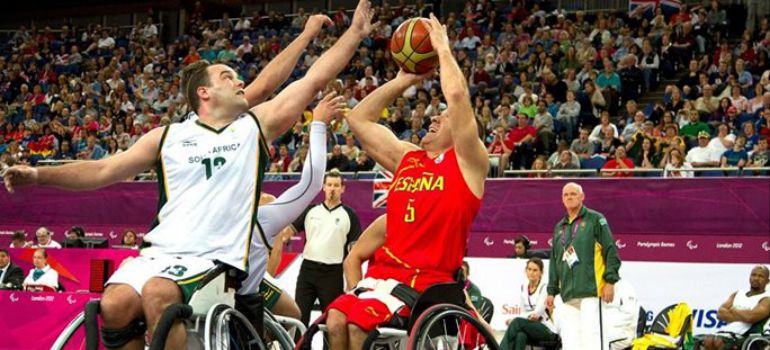Share:
Take it offline!
This Education in Motion resource is also available as a printable PDF.
Download PDF
Wheelchair basketball – widely regarded as one of the most beneficial recreational activities for people with disabilities – is quickly becoming one of the world’s most popular adapted sport. The adapted sport’s popularity is supported by the fact that 75 countries have now established dedicated wheelchair basketball leagues and competitions.
The Origin of Wheelchair Basketball
Wheelchair basketball was originally devised in 1946 by Ludwig Guttmann, a neurologist at Stoke Mandeville Hospital, England. Mr Guttmann was charged with rehabilitating patients – many of whom had been injured on the battlefields of the Second World War – with spinal cord injuries and other physical disabilities.
In his new role, Mr Guttmann, who proved to be a talented rehabilitation specialist, began incorporating a range of new recreational activities in his patient’s rehabilitation programs. Adapted sporting activities soon became the most successful component in Mr Guttmann’s new-and-improved rehabilitation program. The adapted sports, which included: wheelchair netball, wheelchair darts and, eventually, wheelchair basketball, promoted light physical activity and gave Stoke Mandeville patients an opportunity to experience more relaxed social interaction.
The success of Mr Guttmann’s rehabilitation program kick-started a chain of developments within the adapted sporting community. In 1948, the first Paralympic Games were hosted at Stoke Mandeville Hospital and organised by Mr. Guttmann. By the 1950s, wheelchair basketball was rapidly gaining popularity amongst the patients and staff at Stoke Mandeville Hospital. The sport continued to develop and expand until, in 1973, the most important regulatory body in adapted sports, the International Stoke Mandeville Games Committee, established its first adapted sports sub-section when it founded a wheelchair basketball committee. This sub-organisation is still regarded as the precursor to today’s International Wheelchair Basketball Foundation (IWBF).
The Basic Rules of Wheelchair Basketball
There are not many differences between wheelchair basketball rules and Olympic basketball rules. For instance, line location, court size and dimensions, basket height, hoop circumference, game length and ball specifications remain unchanged in wheelchair basketball.

Wheelchair basketball is a fast paced and dynamic game played in four quarters of ten minutes. There is a 24 second shot clock which means within 24 seconds of gaining possession of the ball the team must shoot at the basket. A player can push their wheelchair and bounce the ball at the same time. Once the player picks up the ball and puts it in their lap – they can only push their wheelchair twice before they need to pass, bounce or shoot the ball. Even though wheelchair basketball is a non contact sport, wheelchairs are seen as an extension of a player’s body so contact is common! The game is fast and furious!
The scoring system in wheelchair basketball has been overhauled to help make the sport more accessible to athletes with disabilities. To ensure that games are fair, players are classified from 1 to 4.5. This score accounts for each player’s disability and assesses its impact upon their wheelchair basketball performance. A wheelchair basketball team is composed of five players and the total of their rated scores cannot be greater than 14 points.
What Chair to Use?
Before you begin searching for any adapted sports chair, it’s important to understand the wheelchair requirements of your chosen sport. Wheelchair basketball requires players to use a lightweight court wheelchair that have front and back rollerblade wheels. Wheelchairs are designed to players’ individual specifications in size, height and seat angle. In terms of seat height and angles, low pointers sit much lower with the seat at an angle compared to high pointers who sit at the maximum allowable height that is flat. There are also mid pointers that sit at heights and angles that vary between the high and low pointers. These wheelchairs may also have fixed camber bars and integrated anti-tips in the wheelchair frame to ensure it’s as efficient as possible.
The chairs used in wheelchair basketball are specially designed to maximise speed and manoeuvrability while still withstanding rough impacts from other players on the court. Wheelchair basketball chairs make full use of 4 or 3 main wheels (2 large rear wheels and 2 to 1 smaller front wheels), and feature rear hoop hand support. If you require extra stability, you also have the option to affix 2 castor wheels to your chair’s frame or front axle. Players also wear belts across their hips or thighs.
To ensure that every team member is competing on a level playing field, wheelchair basketball rules stipulate certain conditions on wheelchair accessories and ban the use of ‘illegal’ braking or gearshift features.

RGK - Picking the Right Wheelchair
Some of the most popular wheelchair basketball chairs are designed and manufactured under the RGK brand. RGK Elite basketball wheelchairs are made to measure and to meet your needs and preferences completely!
You can also choose from the popular Quickie All Court models. All Court Sports wheelchairs feature a robust and lightweight frame design. You can also tweak your seating positon by using seat angle and centre of gravity adjustments. If you plan to optimise your chair’s seat angle, take advantage of All Court weight distribution adjustment features to better align your weight on the chair’s drive wheels. Professional wheelchair basketball players can even make use of the All Court Ti wheelchair – a manoeuvrable and robust titanium frame chair.
With so many options available, the only thing left is to choose your own wheelchair and contact your closest adapted sports association.